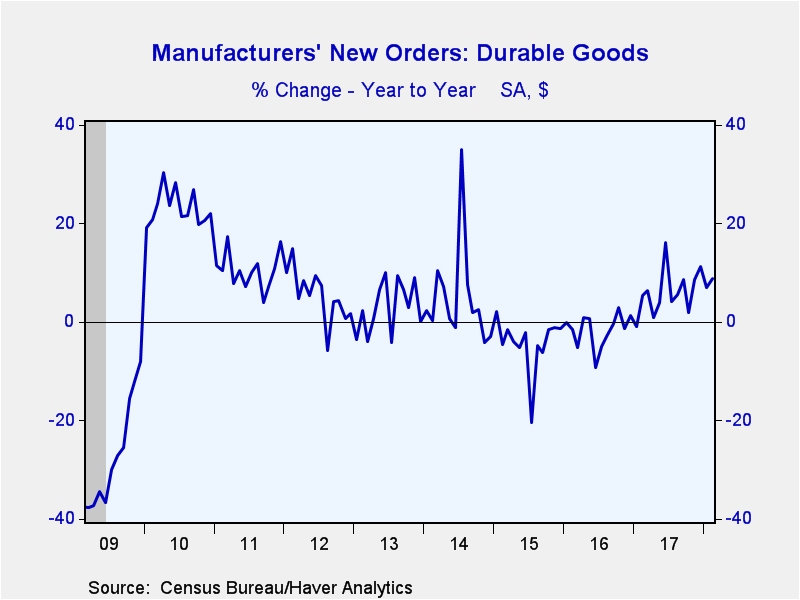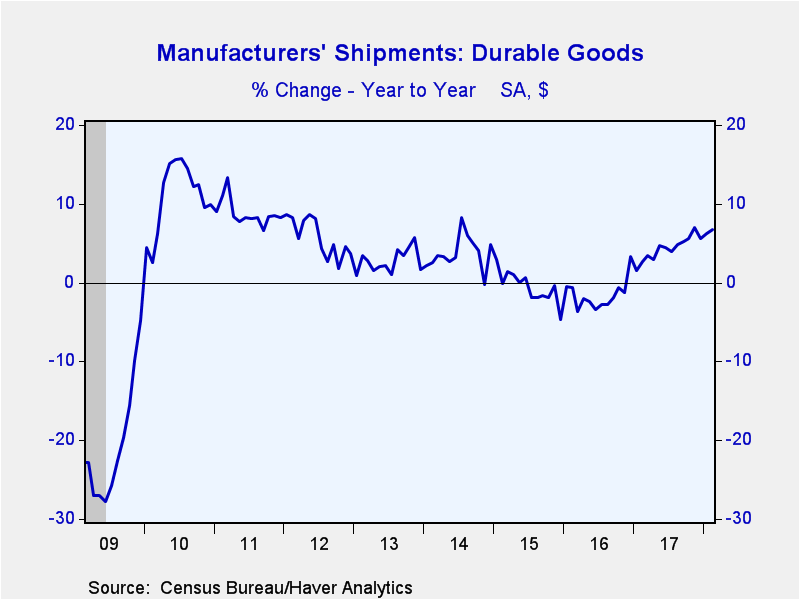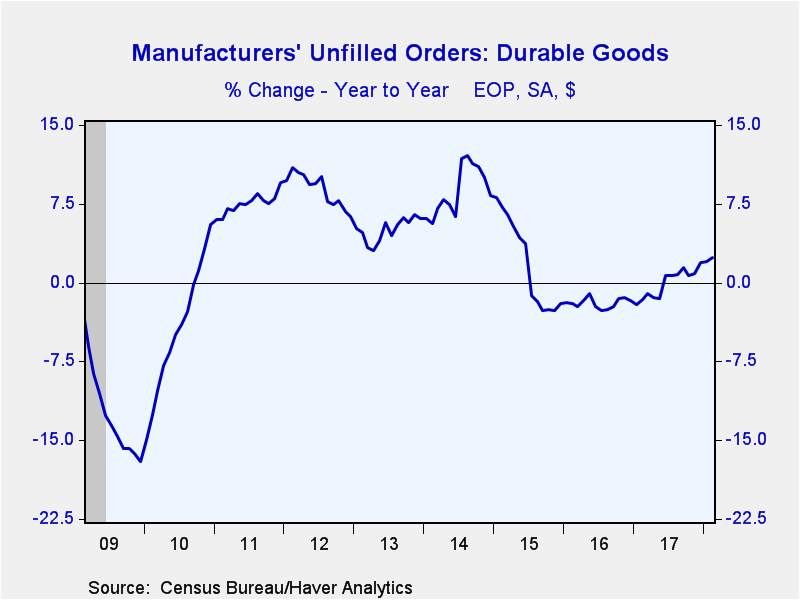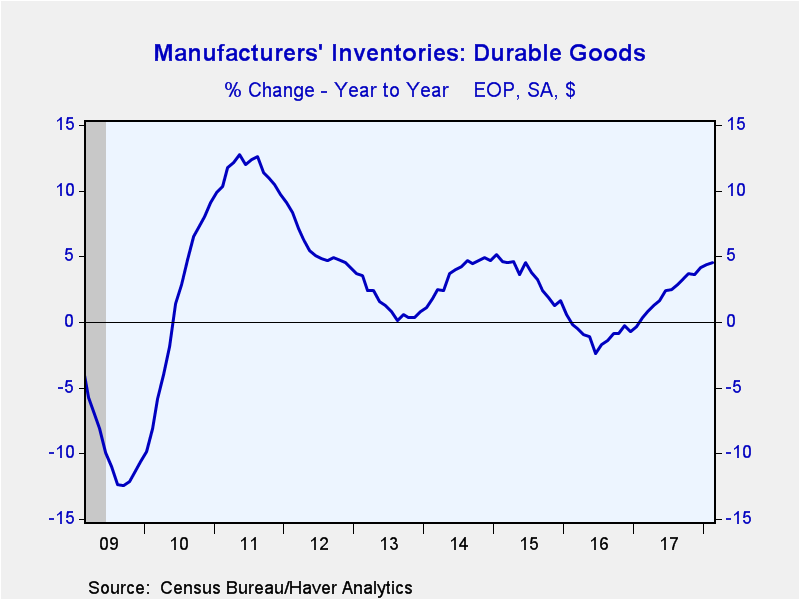 Global| Mar 23 2018
Global| Mar 23 2018U.S. Durable Goods Orders Rebound; Capital Goods Orders Strengthen
by:Tom Moeller
|in:Economy in Brief
Summary
New orders for durable goods increased 3.1% (8.9% y/y) during February following a 3.5% January decline, revised from -3.7%. Expectations had been for a 1.6% rise in the Action Economics Forecast Survey. Transportation sector orders [...]
New orders for durable goods increased 3.1% (8.9% y/y) during February following a 3.5% January decline, revised from -3.7%. Expectations had been for a 1.6% rise in the Action Economics Forecast Survey.
Transportation sector orders continued to provide volatility to the overall orders figure. Last month's 7.1% increase (10.6% y/y) followed a 9.8% decline. Aircraft orders jumped 27.9% after a one-third January drop. Civilian aircraft orders rose 25.5%, and defense aircraft bookings gained 37.7%. Also adding volatility was a 1.6% rise (6.2% y/y) in motor vehicle orders which followed a 0.1% uptick.
Orders excluding the transportation sector increased 1.2% (8.1% y/y) after a 0.2% easing. Orders for primary metals increased 2.7% (12.0% y/y) after a 0.3% rise, and fabricated metals orders improved a steady 0.8% (12.9% y/y). Electrical equipment, appliance & component orders jumped 2.6% (1.1% y/y), after ticking 0.1% higher. Machinery orders strengthened 1.6% (9.6% y/y) after a 0.2% rise. A 0.2% slip (+6.5% y/y) in computer & electronic product orders was led by an 8.4% decline (-6.3% y/y) in communications equipment orders. Computer orders fell 1.1% (-11.7% y/y), the third decline in four months.
In the capital goods sector, orders increased 5.8% (13.0% y/y) after a 4.7% decline. Nondefense capital goods orders gained 4.5% (9.9% y/y) as orders excluding aircraft & parts improved 1.8% (8.0% y/y), after two months of slight decline. Defense aircraft orders strengthened by 16.5% (42.0% y/y), following a 26.4% shortfall.
Shipments of durable goods improved 0.9% (6.8% y/y), following two months of 0.5% rise. Excluding transportation, shipments rose 1.0% (7.4% y/y) after a 0.3% gain.
Unfilled orders for durable goods edged 0.2% (2.3% y/y) after a 0.3% drop. Backlogs of orders excluding transportation rose 0.2% (4.6% y/y) following a 0.1% uptick.
Inventories of durable goods gained 0.4% (4.5% y/y) for the second straight month. Inventories excluding the transportation sector increased 0.3% (5.6% y/y) and repeated January's rise.
The durable goods figures are available in Haver's USECON database. The Action Economics consensus forecast figure is in the AS1REPNA database.
| Durable Goods NAICS Classification | Feb | Jan | Dec | Feb Y/Y | 2017 | 2016 | 2015 |
|---|---|---|---|---|---|---|---|
| New Orders (SA, % chg) | 3.1 | -3.5 | 2.7 | 8.9 | 5.9 | -1.7 | -4.6 |
| Transportation | 7.1 | -9.8 | 6.6 | 10.6 | 4.9 | -3.4 | -6.2 |
| Total Excluding Transportation | 1.2 | -0.2 | 0.8 | 8.1 | 6.5 | -0.7 | -3.6 |
| Nondefense Capital Goods | 4.5 | -1.1 | -0.3 | 9.9 | 7.8 | -7.1 | -11.0 |
| Excluding Aircraft | 1.8 | -0.4 | -0.5 | 8.0 | 5.3 | -4.6 | -4.3 |
| Shipments | 0.9 | 0.5 | 0.5 | 6.8 | 4.3 | -1.6 | -0.6 |
| Unfilled Orders | 0.2 | -0.3 | 0.6 | 2.3 | 1.9 | -1.7 | -2.0 |
| Inventories | 0.4 | 0.4 | 0.5 | 4.5 | 4.1 | -0.7 | 1.6 |
Tom Moeller
AuthorMore in Author Profile »Prior to joining Haver Analytics in 2000, Mr. Moeller worked as the Economist at Chancellor Capital Management from 1985 to 1999. There, he developed comprehensive economic forecasts and interpreted economic data for equity and fixed income portfolio managers. Also at Chancellor, Mr. Moeller worked as an equity analyst and was responsible for researching and rating companies in the economically sensitive automobile and housing industries for investment in Chancellor’s equity portfolio. Prior to joining Chancellor, Mr. Moeller was an Economist at Citibank from 1979 to 1984. He also analyzed pricing behavior in the metals industry for the Council on Wage and Price Stability in Washington, D.C. In 1999, Mr. Moeller received the award for most accurate forecast from the Forecasters' Club of New York. From 1990 to 1992 he was President of the New York Association for Business Economists. Mr. Moeller earned an M.B.A. in Finance from Fordham University, where he graduated in 1987. He holds a Bachelor of Arts in Economics from George Washington University.










